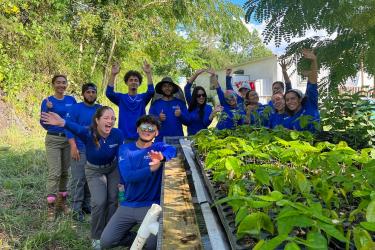Coastal marsh several miles south of Wilmington, North Carolina, was once filled with sediment and choked with invasive reeds that prevented the free flow of nourishing tidal waters. Recently, 10 acres of marsh received a habitat facelift.
In Carolina Beach State Park a recently completed $1.9 million restoration project restored tidal flow that historically fed the marsh. It also removed thick stands of invasive reeds and replanted with native marsh grass species. The marsh will be better able to support nursery, refuge, and foraging areas for Atlantic and shortnose sturgeon, American and hickory shad, striped bass, red drum, and shrimp. It also will provide habitat and feeding grounds for birds and other wildlife.
The restored marsh is a step towards a healthier Cape Fear River basin, which has been impacted by toxic waste releases. Projects like the Carolina Beach marsh restoration help improve water quality in the river basin and absorb impacts from storms. A popular area with boaters and anglers, restoration provides improved recreational experiences for visitors and local communities who have been disproportionately impacted by pollution.
The final phase of construction was completed in late June. Ninety-three volunteers from eight local organizations planted almost 20,000 seedlings of native grasses to recolonize the project site.
This project is one of two habitat restoration projects led by North Carolina Coastal Federation at Carolina Beach State Park. The Federation is also implementing a living shoreline project that includes oyster reefs, intertidal flats, and tidal salt marsh. The living shoreline project will reduce erosion on the shoreline of this popular waterfront park. The project is expected to be completed in winter of 2023.
Restoration Along the Cape Fear River
The effort is one of 10 restoration projects underway in the area. They are all part of the first phase of a restoration plan funded by a $23 million legal settlement to restore the surrounding ecosystem. The resources were harmed by decades of toxic waste releases into the Cape Fear River basin from the nearby Kerr-McGee Chemical Corporation site.
Though operations ceased in 1974, creosote and sludge remaining from wood treatment processes were left on site. These materials leached toxic chemicals into the ecosystem, most notably polycyclic aromatic hydrocarbons—a class of chemicals that occur naturally in coal, gasoline, and crude oil. The contamination impacted marsh habitat and the ecological services they provide, particularly to bottom-dwelling organisms that support the aquatic food chain.
NOAA and its co-trustees—U.S. Fish and Wildlife Service and North Carolina Department of Environmental Quality—continue to coordinate their activities with cleanup actions conducted by the U.S. Environmental Protection Agency and the North Carolina Department of Environment and Natural Resources as part of the Natural Resource Damage Assessment process.

